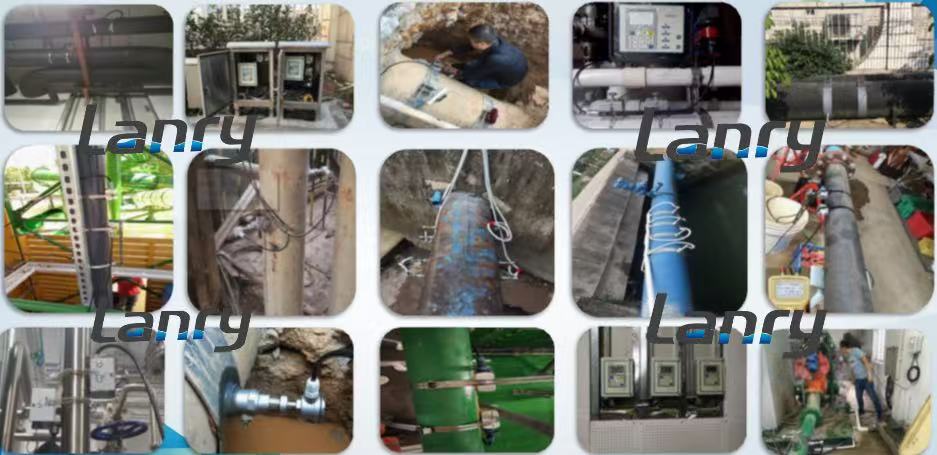Metal Pipes
Carbon Steel Pipes
Carbon steel pipes are among the most common types used in various industries, such as oil and gas, power generation, and general industrial applications. They are highly suitable for clamp - on ultrasonic flow meters. Carbon steel has good acoustic properties, allowing ultrasonic waves to travel through the pipe wall with relatively low attenuation. The homogeneous structure of carbon steel pipes ensures consistent transmission of ultrasonic signals, enabling accurate flow measurement. Additionally, carbon steel pipes are often thick - walled, which further aids in the efficient propagation of ultrasonic waves.
Stainless Steel Pipes
Stainless steel pipes, known for their corrosion resistance, are also compatible with clamp - on ultrasonic flow meters. Similar to carbon steel, stainless steel has favorable acoustic conductivity. The alloying elements in stainless steel do not significantly impede the transmission of ultrasonic waves. These pipes are widely used in industries where hygiene and corrosion resistance are crucial, such as the food and beverage, pharmaceutical, and chemical industries. The smooth inner surface of stainless steel pipes, which helps in reducing fluid flow resistance, also contributes to the accurate measurement of flow rates by ultrasonic flow meters.
Copper and Copper Alloy Pipes
Copper and its alloys, like brass, are excellent conductors of heat and electricity, and they also exhibit good acoustic properties. Clamp - on ultrasonic flow meters can be effectively used with copper pipes. These pipes are commonly found in plumbing systems, especially in residential and commercial buildings. The relatively thin walls of copper pipes in some applications do not pose a major problem for ultrasonic measurement, as the high acoustic conductivity of copper compensates for the wall thickness. Copper alloy pipes, with their unique mechanical and chemical properties, are also suitable for ultrasonic flow measurement in specific industrial applications where corrosion resistance and good flow - related characteristics are required.
Plastic Pipes
Polyvinyl Chloride (PVC) Pipes
PVC pipes are widely used in water supply and drainage systems, irrigation, and some industrial applications. Clamp - on ultrasonic flow meters can be used to measure the flow in PVC pipes. Although PVC has a lower acoustic velocity compared to metals, the ultrasonic waves can still propagate through the pipe wall. The lightweight and cost - effective nature of PVC pipes make them an attractive option for many applications, and the ability to measure flow non - invasively using ultrasonic technology further enhances their usability. However, it is important to note that the accuracy of measurement may be affected by factors such as the thickness and quality of the PVC pipe.
High - Density Polyethylene (HDPE) Pipes
HDPE pipes are increasingly being used in water distribution networks, gas pipelines, and sewer systems. They are also compatible with clamp - on ultrasonic flow meters. HDPE has a relatively uniform structure, which allows for the efficient transmission of ultrasonic waves. The flexibility and durability of HDPE pipes, combined with the non - invasive measurement capabilities of ultrasonic flow meters, make them a popular choice for infrastructure projects. The acoustic properties of HDPE can be well - understood and calibrated, enabling accurate flow rate determination.
Polypropylene (PP) Pipes
PP pipes are used in applications where chemical resistance and high - temperature tolerance are required, such as in the chemical and food processing industries. Clamp - on ultrasonic flow meters can be employed to measure the flow in PP pipes. The acoustic behavior of PP pipes is such that ultrasonic waves can travel through them, facilitating flow measurement. The non - corrosive nature of PP pipes, along with the non - invasive measurement method of ultrasonic flow meters, provides a reliable solution for monitoring fluid flow in harsh chemical environments.
Composite Pipes
Fiberglass - Reinforced Plastic (FRP) Pipes
FRP pipes, which combine the strength of fiberglass with the corrosion - resistance of plastic, are suitable for clamp - on ultrasonic flow meters. The fiberglass reinforcement provides structural integrity, while the plastic matrix allows for the transmission of ultrasonic waves. FRP pipes are often used in applications where corrosion resistance is a primary concern, such as in wastewater treatment plants, marine environments, and chemical processing facilities. The non - metallic nature of FRP pipes, in combination with the non - invasive ultrasonic measurement technique, offers a cost - effective and reliable solution for flow monitoring.
In conclusion, clamp - on ultrasonic flow meters can be used with a wide range of pipe materials, including various metals, plastics, and composites. This versatility makes them a valuable tool for flow measurement in different industries and applications, enabling efficient and accurate monitoring of fluid flow without the need for invasive installation methods.

Post time: Feb-24-2025

